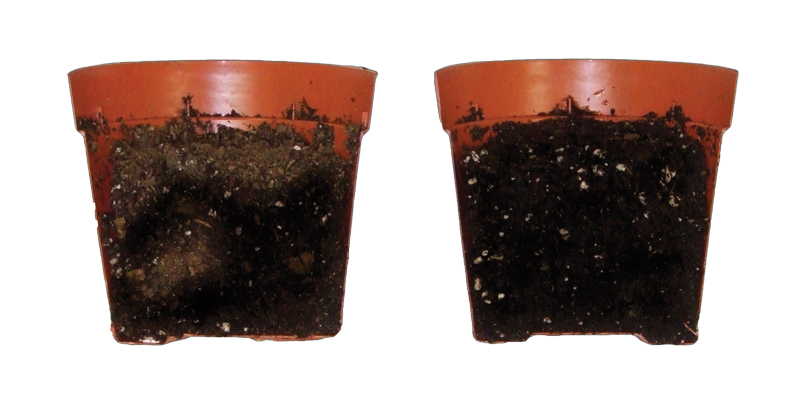
Reduce Waste with a Quality Surfactant Program
It's no secret that plants need access to water and nutrients to grow healthy and strong. This has been true since the beginning of time. However, there are a number of challenges to providing plants with the water and nutrients they need, especially in the greenhouse environment where the use of soilless growing media is common.
There are a number of reasons why soilless mixes are used in the greenhouse industry. These man-made substrates are completely pathogen-free, which protects plants against disease and competition from weeds. And unlike natural soils, these mixes do not contain fine-textured particles like clay, which can lead to compaction and restricted root growth.
Despite the many benefits of soilless mixes, there are also a few disadvantages. Most soilless growing mixes are made up of various combinations of peat, bark and other amendments that are naturally hydrophobic. As such, once they are allowed to dry, these mixes are prone to the development of water repellency, a problem that interferes with proper water, air and nutrient management.
Growing media that has become water repellent can no longer absorb water effectively. Untreated water repellency can result in water ponding on the surface or channeling through pots before the plants can make use of it. Even pots that seem to be wetting normally may contain pockets of repellent media beneath the surface, leading to inconsistent root growth and a variable crop.
An initial surfactant treatment is included in most commercial mixes on the market today. This initial charge helps the mix to wet, drain and perform well early in production. However, this surfactant treatment degrades over time and cannot prevent the development of water repellency in the later stages of production or in the retail environment. Consequently, soilless mixes become less uniform and less effective as time goes on.
This is a challenge for growers and retailers. Throughout production, plants need adequate amounts of water and nutrients to reach their full potential, yet the development of water repellency reduces the mix's ability to meet those needs.
Incorporating a quality surfactant into your treatment program will help to keep soilless mixes from becoming water repellent. In turn, plants will be better able to make use of applied water and chemical inputs and remain looking their best. The end result is a reduction in waste, more uniform crop production and ultimately more plants sold at the retail level.
Reduce Water Use
Research has shown that plants thrive when a quality surfactant is applied during the production cycle. This practice ensures that water repellency is addressed in an ongoing basis, so that mixes continue to wet and drain uniformly from initial planting through the final sale. Preventing the onset of water repellency and encouraging uniform wetting reduces the amount of water needed to grow healthy plants.
The chart below shows the amount of water applied to a variety of plants growing in soilless mixes treated with AquaGro L with PsiMatric Technology, a media surfactant from Aquatrols, compared to plants growing in untreated mixes. As you can see, the plants growing in the treated mixes required significantly less water than those growing in untreated mixes. AquaGro L has proven to reduce watering rates by up to 20 to 50 percent, depending on the plant species and growing mix in question.
This improved water efficiency is critical for growers who are paying increasingly high rates for water and those in drought-afflicted areas who may be facing the prospect of water-use restrictions.
Increase Time Between Irrigation
A quality surfactant program not only reduces the amount of water needed to grow healthy plants, it can also increase the amount of time between each irrigation event. The chart below shows the average number of days between irrigation cycles for New Guinea impatiens, a 56-day crop. A surfactant treatment increased the average number of days between necessary irrigation cycles by three days.
By reducing the amount of time spent irrigating or hand watering, a quality surfactant program creates an additional source of labor and monetary savings for growers.
Improve Efficiency of Applied Inputs
Fertilizers and other chemical inputs are often necessary to produce a consistent, healthy crop, but they can also be very expensive. A proven surfactant program will help you get the most bang for your buck during each application.
By encouraging uniform distribution of water in your growing media, you will also improve the distribution of all other applied inputs. This results in improved root uptake and a significant reduction in the amount of product leached through your pots. The photos below show the amount of leachate collected from untreated and surfactant-treated pots after a series of irrigation cycles. Note the differences in the amount of leachate present in each container.
This increased efficiency can reduce the amount of expensive fertilizer and chemical applications that are needed over the course of a growing season, serving as a significant source of monetary savings.
Ease of Application
Incorporating a surfactant product into a treatment program is a fairly simple and straightforward process. AquaGro L, for example, can be added into a water-soluble fertilizer tank mix and applied during each fertilizer application.
It can also be injected on a weekly or monthly basis during irrigation cycles, depending on your specific needs. For just pennies a pot you can implement a flexible surfactant program that will reduce your watering needs, improve the efficiency of expensive chemical inputs, and produce a healthier, better looking, more saleable crop.
Research report cited: Influence of Aquatrols AquaGro L with PsiMatric Technology On Water Management and Crop Growth (Dr. C.L. Bethke, Horticultural Soils & Nutrition Consulting, Williamston, MI, 1999)
Reduce Waste with a Quality Surfactant Program


 Video Library
Video Library 




















